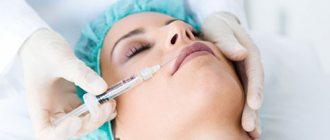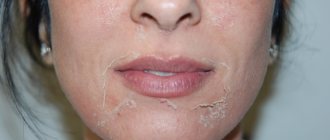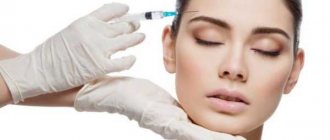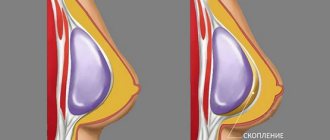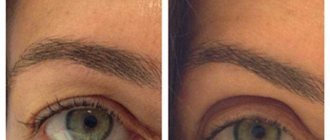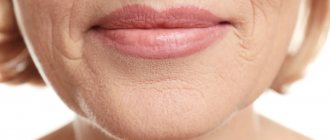Reminder after chemical peeling
To ensure that your facial skin recovers quickly after chemical peeling and there are no complications, you must strictly follow the recommendations from the leaflet:
- The first wash with cool water should take place no earlier than 48 hours after the procedure.
- For water procedures, use only cosmetics (gels, mousses, etc.) marked “for sensitive skin.”
- In the first 7 days after the procedure, finish the water procedures by rinsing your face with acidified water (250 ml of water + 1 teaspoon of 6% table vinegar).
- Before going outside (even if the weather is cloudy), apply sunscreen to your face - the duration of its use and the SPF level should be determined by a cosmetologist.
- To care for your facial skin, you need to use products that contain acids - this will preserve the results for a long time.
- For 20-25 days you need to avoid sunbathing and tanning in a solarium.
- After 5 days, you are allowed to take thermal procedures - hot bath, sauna, steam bath.
We recommend reading about TCA facial peeling. You will learn about who this procedure is indicated for, the medications used to carry it out, the procedure, and side effects. And here is more information about superficial peeling, its advantages and methods of implementation.
Preparing the skin for chemical peeling
To achieve the best peeling effect and reduce the risk of possible side effects, the skin must be prepared. For this purpose, glycolic acid preparations of 8–25% and pH more than 2 are used. The duration of home preparation depends on the initial condition of the skin and the type of aging and can range from 1 to 4 weeks. In the presence of hyperpigmentation, pre-peeling preparation also includes bleaching agents (ascorbic acid, arbutin, kojic acid, etc.). Retinoids are also used for pre-peeling preparation. When preparing the skin for peeling, it is important to pay attention to the blood vessels. With age, blood circulation in the skin worsens, which is manifested by a change in complexion, the disappearance of a youthful glow, and the appearance of bluish shadows. And its regeneration depends on the state of microcirculation in the skin. With poor microvascular development, regeneration slows down. Sometimes the cause of slow regeneration is a lack of certain microelements (for example, zinc), essential fatty acids (PUFAs), and vitamins. Therefore, it is recommended to take medications containing polyunsaturated fatty acids. In my practice, I widely use the drug from Danne Kefa. It is recommended both during pre-peel preparation and post-peel preparation. 2 days before the procedure, stop using medications with AHA acids; men should not shave before the procedure in the morning. Also prohibited a week before the procedure are any manipulations that violate the integrity of the skin - mesotherapy in the peeling area, bioepilation, electrolysis, cleansing and the use of any scrubs.
Possible complications after peeling
At the end of the procedure, the skin looks burned and has an unnatural color. This symptom will then increase for another day or two. Some soreness, a feeling of dryness, and slight swelling are possible.
Then a film on the surface becomes visible, which after some time begins to peel off in parts, exposing young skin. All of these are common consequences of using TCA peels. But more serious symptoms may also occur, which are already considered complications:
- Herpes after peeling, herpetic rashes;
- skin infection, leading to the appearance of purulent formations;
- white spots caused by a violation of pigment production;
- a visible line between the peeled skin and areas not affected by the procedure;
- persistent erythema, that is, long-lasting redness of the skin;
- hyperpigmentation;
- exacerbation of acne.
The cause of ailments that worsen well-being and appearance is not only the incorrect implementation of the procedure itself. Complications are also caused by lack of proper care.
Face swollen after peeling
If your face is swollen after a chemical peel, then only time will help solve the problem - it’s not for nothing that doctors recommend ensuring that you stay at home for 1-3 days during the procedure. The tumor is uniformly swollen without pronounced foci of excessive protrusion, there is no pain or burning.
If the face does not return to normal, and the complication does not become less pronounced even 24 hours after cosmetic manipulation, then you should seek help from a doctor - either swelling is developing, or some pathological processes such as inflammation are occurring in the skin.
Skin irritation after chemical peeling
During chemical peeling, the skin of the face is exposed to aggressive effects, so irritation on it after the procedure is considered normal and falls into the category of harmless consequences. It manifests itself in the form of mild redness, itching and mild burning. These unpleasant sensations disappear on their own within 2-3 days of the recovery period.
To alleviate the condition, cosmetologists recommend washing with cool water and applying cold wipes.
Swelling after chemical peeling
Trauma to the skin during chemical peeling leads to the development of swelling after the procedure. It forms almost immediately and can grow/expand within 2-3 days, after which it becomes less pronounced. As soon as you can wash your face, you should apply cool compresses to your face for 10 minutes every 2-3 hours - this will speed up the recovery process.
Severe swelling may be associated with severe fluid retention in the cells of the dermis, so it would be advisable to take diuretics for 2-3 days. But such therapy should be carried out only as prescribed by a doctor.
Hyperemia and swelling of the periorbital area
Erythema after triacetic acid
Erythema after peeling with triacetic acid is an expected complication, which is a pronounced redness of the treated areas of the face. The problem appears literally in the first hours after the manipulation, and can persist for 4 hours – 5 days.
A more specific period depends on the concentration of triacetic acid used for the procedure: if it was a median TCA, then erythema may be present for 5 days, but when using alpha hydroxy acids, the problem disappears on its own after 4 hours.
Erythema is never accompanied by swelling, has almost clear outlines and does not bother the patient with pain, itching or burning.
Red spots after chemical peeling
The appearance of red spots after a chemical peel may be due to ordinary skin irritation or damage to the walls of blood vessels that are located close to the upper layer of the dermis. In the first case, the spots will have blurry boundaries and be randomly located on the face. And when the vessels are damaged, they are distinguished by their brightness and visually defined contour, the formation of pinpoint subcutaneous hematomas.
If this phenomenon does not become less intense after 4-6 days, then you should seek qualified medical help. Additional therapy may be needed.
TCA peeling
If you are already tired of problematic skin, if you have to apply a huge amount of foundation to your face every day to hide acne scars, dull complexion or telltale wrinkles, then it’s time to act! The problem can and should be solved - just undergo TCA peeling sessions at the Cleo Line Cosmetology and Beauty Center.
About the procedure
What is TCA peeling? The abbreviation TCA is adopted for ease of pronunciation and stands for TriChloracetic Acid - trichloroacetic acid.
TCA peeling is a non-invasive and non-surgical method of rejuvenation and correction of skin problems. Using an individually selected concentration of acid, an experienced cosmetologist will help the patient get rid of wrinkles, scars, chickenpox marks, and freckles. The effect of the procedure: lifting and outwardly noticeable rejuvenation. This is explained by the dissolution and removal of old, dead skin cells and the increased formation of new ones.
What problems does it solve?
TCA peeling will help cope with age-related changes in the skin: reduced elasticity, sagging, wrinkles that have appeared on the forehead, near the lips. Peeling is also effective if:
- skin irregularities
- hyperkeratosis (thickening of the stratum corneum of the epidermis)
- hyperpigmentation
- birthmarks (flat)
- melasma (skin pigmentation disorder)
- enlarged pores
The procedure will also help lighten the skin, smooth out scars and acne scars, restore an even complexion and remove stretch marks on the body.
How is the procedure done?
After consulting with a cosmetologist and identifying existing defects, the specialist will independently select the concentration of the drug for a particular patient. The client's skin is degreased and wiped with a disinfectant solution. Then, using a brush, the doctor applies the drug solution.
There may be discomfort for the patient, but it all depends on the pain threshold and acid concentration. The exposure time of the exfoliant is approximately 5-7 minutes. After this, the doctor neutralizes the effect of the acid on the skin by washing off the composition. A post-peeling mask is applied to the treated area - it is needed to soothe the skin.
After the session, the skin turns red, swelling occurs, and a burning sensation may be felt. After a day, crusts will form on the face, and after 4-5 days, peeling of skin particles will begin. It will stop completely on the tenth day, and then it will be possible to evaluate the effect of peeling. The final result is visible after 30 days, and it is then that you can decide whether to repeat the session.
Number of procedures and frequency
The number of sessions will depend on the patient’s skin type and the number of problem areas on the face. On average, 2-3 sessions are enough. It is necessary to wait at least a month between procedures.
Result
A TCA peeling session enhances blood microcirculation in tissues, improves the structure of the epidermis, and reduces the thickness of the stratum corneum. As a result, the skin acquires elasticity, a beautiful and even color, and becomes smooth and elastic. The “depressions” on the skin from chickenpox and acne are smoothed out (they seem to be pushed out from the inside), small wrinkles “go away”, the skin looks young and toned. When peeling is performed on the body after peeling is complete, stretch marks and stretch marks disappear, the skin tightens and becomes smoother.
A drug
The drug is a solution of Trichloracetic Acid of different concentrations.
It affects the skin as:
- Exfoliant (causing peeling)
- Triggers regeneration
- Stimulates the launch of anti-inflammatory and antibacterial processes
- Has a lifting effect (strengthens metabolic processes and stimulates the production of collagen and elastin)
The substance causes coagulation of protein substances that make up the epidermis. Because of this, old cells are destroyed and the formation of new ones is stimulated. Acid molecules are able to “fall through” to the basal layer, which enhances the stimulation of young cell division.
Why us
Chemical peeling is a fairly serious procedure that is best left to professionals. Our experience (more than 7 years) in the field of cosmetology allows us to carry out the chemical peeling procedure as efficiently as possible with excellent results.
The Cleo Line Center employs highly qualified specialists with higher medical education.
There is an expression: “Choose a cosmetologist through beautiful friends.”
You can read reviews about our Center, look at publications on Instagram or in our VKontakte group. More than a thousand people have already become our regular customers! We will be glad to see you among our regular visitors. Read more
Skin care to prevent problems
In the salon it is not always possible to get complete information about what to do after peeling. In addition, questions about this may arise later. The sensations and external signs at the end of the procedure also remain a mystery to many. So it will be useful to know how the peeling will end; post-peeling care day by day is a particularly important point. It includes several components:
- external skin products;
- ensuring an external favorable environment;
- drugs taken orally;
- prohibitions.
What to apply to the skin
Immediately after the procedure, the surface of the skin is an inflamed membrane. Therefore, for the first day it is better not to touch the face and area of the body where the peeling was performed. And if it was a moderate impact, you should not touch the surface for up to 2 - 3 days. You cannot wash your face during this period; you can only gently treat your eyes and rinse your mouth. What cosmetic products should you use:
- After the specified time, you need to apply “Bepanten” or “D-Panthenol” to the skin 3 - 4 times a day, blotting with a napkin after 20 minutes. These are anti-inflammatory and regenerating agents, which, however, may initially cause tingling.
- At the same time, you are allowed to wash your face using products that do not contain alcohol, abrasive particles, fats or hydrophilic oils. Ampoule serums and concentrates are best suited. After washing your face, you should not wipe it, but carefully pat it dry.
- Later, when the skin is covered with a tight, dry film, Bepanten and D-Panthenol can be alternated with formulations containing aloe, witch hazel, and zinc. Such skin care after TCA peeling will help preserve moisture, heal damaged tissues faster, and prevent scars from appearing.
- Those who often have relapses of herpes should apply the appropriate external agents - Viferon or Acyclovir - 2 - 4 days after the procedure.
- Products with ceramides will help increase moisture levels. Similar care after TCA peeling is indicated after the film begins to fall off. It will restore the skin's protective barrier.
- When going outside, once the “wet” stage has passed, be sure to use a high-level sunscreen. This will help avoid hyperpigmentation and disruption of melanin production.
- After the entire face is covered with young skin, biorevitalization can be done. This will be approximately a week after the superficial procedure, 14 - 20 days after the mid-peel.
Watch this video about what external products to use after facial peeling:
External environment
With such an aggressive effect as TCA peeling, post-procedure care should also include creating an external environment favorable to the skin. Now neither heat nor cold is good for her. Therefore, it is better to spend the first time at home, especially since the appearance of your face is not conducive to going out into the world. Sunlight should be avoided if possible.
For this purpose, the procedure is usually prescribed in autumn or winter. In a home environment, high humidity and too dry air are also undesirable.
What to take orally
Recovery from a TCA peel is not a disease. However, it is important to pay attention to the following points:
- for the first 2 - 4 days, eat crushed food so as not to provoke pain and damage to the skin, and drink liquid through a straw;
- During the entire 2-3 weeks of the rehabilitation period, drink a lot of water to increase skin moisture;
- It would be good to take vitamin-mineral complexes with zinc to help the formation of new cells;
- Alcohol, which interferes with healing, should be avoided.
What product to wash after TCA
You can wash your face after TSA only with products that do not contain abrasive particles, alcohol, or hydrophilic oils. The packaging should be marked “for sensitive skin”. Cosmetologists recommend choosing mousses, gels, and foams with a light structure - the skin is damaged after aggressive cleansing, so you need to act on it as gently as possible.
We must not forget about the need to rinse the face after the main water procedure with acidified water.
Why wash your face with acidified water after peeling?
After TCA peeling, you need to wash your face only with acidified water (this will be the last stage of the hygiene procedure), because this:
- the process of exfoliation of epidermal particles is significantly accelerated;
- the period of skin restoration is reduced - for example, the stage of active peeling becomes several times shorter;
- the skin dries out, which prevents the crusts from getting wet and becoming infected;
- disinfection of the “wound” surface is carried out.
Pharmacy products after peeling
To accelerate the regenerative processes in the dermis after peeling, it is worth using specific pharmaceutical products:
- Arnica gel – soothes the skin, relieves swelling and redness, moisturizes it, cools and accelerates metabolic processes (metabolism);
- Bepanten is a hypoallergenic cream, designed to accelerate the healing process of various wounds, stimulates the growth of new dermal cells, nourishes the skin with vitamins (the composition contains representatives of the B line);
- D-Panthenol spray is a very convenient form of the drug, because it allows you to treat your face after peeling without touching it with your hands (this is what cosmetologists recommend), accelerates regeneration at the cellular level, normalizes metabolic processes, and increases local immunity;
- Solcoseryl ointment - can replace both Bepanten and D-Panthenol, has an analgesic effect, activates the “breathing” of dermal cells, which leads to their full saturation with oxygen and nutrients.
All pharmaceutical products are used on the 3rd day after chemical peeling (unless otherwise prescribed by the doctor), you need to apply them 3-5 times a day in a thin layer and leave until completely absorbed.
Scrub after chemical peeling
If superficial chemical peeling was carried out, then the scrub after the procedure can be used literally for 3-5 days. But such a product should have a minimum of abrasive particles, and after using it, the facial skin is immediately wiped with lotion/tonic and lubricated with moisturizer.
If a medium or deep chemical peel has been performed, then it is strictly forbidden to use scrubs until the skin is completely restored. In the future, there are no special features in carrying out procedures with this product.
Watch this video about what not to do after a chemical peel:
Masks after chemical peeling at home
After chemical peeling, you can and should use masks that are prepared at home - they soothe irritated skin, promote its hydration, which causes rapid exfoliation of epidermal particles and healing of the surface.
You can avoid using complex recipes and simply treat your face with cosmetic oils - for example, from grape seeds, peach, almond. It would be optimal to spray them over the surface in order to comply with the cosmetologist’s recommendations regarding avoiding contact of fingers with the face.
Alginate
To prepare an alginate mask at home, you only need alginate mixture powder (sold in pharmacies or specialty stores) and still mineral water. You need to prepare a mixture that visually resembles a thin cream. It is applied to a previously cleansed face (after chemical peeling, it is simply wiped with lotion without alcohol in the composition) and left for 20 minutes, after which it is removed and the skin is wiped with a light, soft tonic.
Alginant mask
Alginant mask:
- moisturizes;
- accelerates exfoliation of epidermal particles;
- relieves swelling and redness;
- accelerates regeneration.
Calming
To relieve discomfort after chemical peeling, you should use a soothing mask based on milk, honey, egg yolks and aloe pulp/juice. The following combinations are suitable:
- 1 tablespoon milk + 1 tablespoon honey + 1 chicken yolk;
- 1 teaspoon oatmeal + 2 tablespoons milk + 1 teaspoon honey + 5 drops aloe juice.
You can start using such products from the 3rd day after the manipulation, provided that the cosmetologist has given permission to do so.
TCA peeling
| CHEMICAL PEELING | ||
| Procedure code | Name of procedure | price, rub. |
| А16.01.024.010 | TCA peeling “Tcapeel” 15% (for skin cleansing) | 5500 |
| А16.01.024.011 | TCA peeling “Tcapeel” 25% (for skin cleansing) | 7000 |
Characteristic features of the TCA peeling procedure
Peeling gained popularity back in the last century, when the first clinical data appeared confirming the ability of the peeling active substance to reduce keloid scarring by 25 percent.
In general, peelings are divided into deep, medium and superficial. The peeling category depends on the depth of action of the active peeling composition on the skin.
TCA peeling targets the middle tissues of the skin. The abbreviation etymologically goes back to the English term “trichloroacetic acid”.
Experts do not recommend using manipulation more than once every 12 months. This is due to the fact that if you are too enthusiastic about the procedure, skin laxity may appear. Many may be intimidated by the very name of the peeling and the fact that it is carried out with an acid composition. But we should immediately make a reservation that the active substance is not toxic to humans. The degree of impact on the skin is determined by the following factors:
1) percentage of concentration of the active substance in the peeling preparation;
2) the number of layers that cover the target area during manipulation.
The most successful time for carrying out manipulation is the period from the end of the autumn season to the beginning of the spring season inclusive. This is due to the fact that during this period of time solar exposure is least active.
If the manipulation is carried out in the summer, there is a risk of burns or age spots.
The principle of TCA peeling on tissue
TCA peeling affects the epidermal layer in several directions at once. The basic characteristics of trichloroethanoic acid include the following:
- deep cleansing of the skin. The upper epithelial layer becomes smooth and youthful;
- regenerative processes. The active peeling substance acts on the deep layers of the skin and triggers restoration processes, during which many young cells are formed. As a result, new structural formations are more resistant to inflammation, disease and age-related changes in the skin;
- neutralization of inflammatory processes. The active peeling substance helps normalize the production of sebum by the sebaceous glands, narrowing enlarged pores and destroying sebaceous plugs, which previously provided a beneficial environment for the proliferation of bacteria;
- acceleration of cellular metabolism: TCA peeling starts suspended metabolic processes and accelerates the resulting ones, improves the synthesis of collagen and elastin fibers, on which the elasticity of the skin, youth and healthy skin condition depend;
- To get rid of scars and scarring, it is necessary to use the active peeling substance in a concentration of at least 30%.
Indications and contraindications for TCA peeling
Before you decide to undergo manipulation, you need to visit a dermatologist to assess the condition of the body and skin. Only a qualified specialist can give rational recommendations on whether to use the procedure or not.
Before carrying out the procedure, it is also necessary to study the range of contraindications to the manipulation.
Typical situations in which TCA peeling is indicated include the following:
- the presence of facial wrinkles in the areas of the eyes, forehead, cheeks and mouth;
- increased activity of the sebaceous glands and overly noticeable pores;
- traces of post-acne - scarring, scars, uneven skin texture;
- the presence of stretch marks associated with a sharp increase or decrease in weight;
- age-related changes in tissues, ptosis, loss of firmness and elasticity.
The list of contraindications includes the following conditions and diseases:
- violation of the integrity of the skin in the target area, infection of the target area;
- herpetic infection;
- tendency to keloid scarring;
- pregnancy and feeding;
- allergic reactions to the components of the active substance of the peeling;
- excessive hair growth;
- menstruation period;
- carrying out manipulations that involve trauma to the skin within 60 days before the TCA peeling procedure;
- endocrine diseases;
- oncology.
The result of the procedure is directly related to the degree of intensity of the impact, the personal characteristics of the patient, the client’s age category, lifestyle and other parameters.
TCA peeling is considered a procedure that involves microtrauma and pain. If you do not pay attention to the list of contraindications for the procedure or ignore subsequent skin care, complications may occur:
- if the client had herpes, complications and injuries may increase;
- in some situations, keloid scarring appears in target areas;
- excessive pigmentation of the epidermal layer is possible;
- a border line between skin structures may appear at the target area.
Stages of the procedure
The peeling procedure consists of several stages. Compliance with the order of stages is necessary in order to achieve the best effect after exposure to the skin. The number of stages of exposure is related to how deep the peeling acts. The duration of the procedure is most often 20-40 minutes.
It is necessary to understand that all types of TCA peels involve pain, and while the substance is left on the skin, the client may feel an increased burning sensation.
During the manipulation of TCA peeling, which acts superficially, most often only a slight tingling sensation is possible without an accompanying discomfort.
In order for the effect of the manipulation to be prolonged and noticeable, you should prepare for the procedure:
- resort to glycolic peeling;
- Avoid prolonged exposure to active sun;
- permanently use cosmetics with an SPF filter;
- take medications that strengthen blood vessel walls;
- refuse epilation and scrubbing.
Manipulation protocol
- The skin is cleansed. A cosmetologist uses a lotion or other cleanser to rid the skin of cosmetics, sebaceous secretions and other types of dirt. With this step, the epidermal layer is prepared for treatment with the active substance.
- Layers of peeling are applied. As mentioned above, the number of layers is determined by the depth of exposure. Target areas are usually coated with one, two or four layers. Air flow is used to relieve itching.
- The skin is cleansed and soothed. The specialist cleanses the epidermal layer of the peeling substance using acidic water or an alkaline composition, then the skin is covered with soothing agents.
- Care after the procedure. After the manipulation, white spots may appear on the target area. This occurs only with deep and medium types of exposure. If superficial peeling was performed, pinkishness is likely to appear. There is no need to be afraid of such manifestations, since such an effect disappears within 2 days after the manipulation.
Ten guaranteed peeling effects - TCA
After the manipulation you can see the following changes:
- the skin texture becomes more uniform; the epithelium acquires elasticity and youth;
- the shade of the epidermis looks healthier;
- signs of photoaging disappear;
- keloid scarring is reduced;
- acne goes away;
- inflammation of the skin decreases;
- there is a narrowing of the pores;
- normalization of sebum production;
- getting rid of excessive pigmentation or lightening;
- acceleration of metabolic processes of the skin, launch of regenerative processes.
Recovery process
After the manipulation, swelling, dry skin and pain are possible. After a few days, brown-brown crusts appear. It is forbidden to peel off the crusts, as such actions can cause scarring.
The falling off of crusts, as a rule, starts 7 days after the procedure. Under the crusts, renewed skin of a pinkish tint appears. After a few days, young skin merges in shade with the epidermal color of other areas.
Trichloroacetic acid exfoliates tissue at a deep level, so the rehabilitation period can reach 14 days. If the patient cannot tear himself away from school or work, it is recommended to use a superficial peel or a more delicate procedure such as peeling with salicylic or glycolic acids.
Tips for the recovery period
TCA peeling, due to its increased effectiveness, involves trauma to the skin. But if superficial peeling was performed, no rehabilitation period is required.
If the peeling was medium, in which a concentration of the active substance of 20-30 percent was used, peeling and redness occur, which disappear after a few days.
During this period, you must adhere to the following recommendations. Do not wash your face with water for 2 days. The specialist will prescribe the use of soft cosmetics such as foams and lotions, taking into account the characteristics of the patient’s skin. To enhance the effect of these products, fruit acids are added to the composition in small concentrations in combination with vitamin complexes. It is necessary to constantly use sunscreen cosmetics when going outside (minimum SPF30). Sometimes experts advise carrying out biorevitalization in order to consolidate and enhance the effect of TCA peeling. Biorevitalization using hyaluronic acid can have a positive effect on the result of peeling, adding to its properties of exfoliation and skin renewal an internal beneficial effect with nutrition and rejuvenation of the skin.
It is important to note that after the manipulation the following unpleasant moments are possible:
herpes if the patient has a tendency to develop a herpes infection, but does not maintain a healthy state with medications. In such a situation, you need to consult a doctor;
pigmentation. Such a nuisance may arise if the procedure was carried out in the summer or if the patient peeled off the scabs;
blackheads A similar situation can occur if the specialist has chosen the wrong procedure method. It is forbidden to treat acne lesions with drugs and formulations containing alcohol. You can use antiviral medications containing zinc;
the appearance of allergic reactions. To prevent the occurrence of allergies, it is necessary to first donate blood for intolerance;
scars. They may appear in clients who independently got rid of the crusts that appeared.
If you carefully read the recommendations, you can conclude that complications most often occur when the patient acts incorrectly, expressed in non-compliance with recommendations for care after the procedure and insufficient awareness of the doctor about the client’s medical history and condition. This means that it is necessary to notify the cosmetologist about the presence of certain diseases, the presence of contraindications, and also adhere to the rules for healing the skin after exposure.
Why does my face not peel off after a chemical peel?
After a chemical peel, the face may not peel off; the reasons may be:
- the peeling was gentle - cosmetologists perform this if the patient is undergoing this procedure for the first time;
- Glycolic and fruit acids were used as the main means - they allow only superficial cleansing of the dermis;
- peeling went almost unnoticed - this happens in those people who constantly monitor their face and regularly perform cleansing procedures;
- human skin is resistant to damage.
The absence of peeling does not mean that the peeling was ineffective.
Examination of the patient and choice of chemical peeling
During the initial examination of the patient, it is necessary to pay attention to the predominance of one of the types of aging, the presence of hyperpigmentation, foci of inflammation in the peeling area, the state of skin turgor and elasticity, and the degree of its hydration. Particular attention is paid to the severity of cosmetic defects. Contraindications to the procedure are identified. These include: pregnancy and feeding, dermatoses in the acute stage, acute respiratory viral infections, violation of the integrity of the skin, exacerbation of herpes virus infection, taking systemic retinoids, a tendency to form hypertrophic and keloid scars.
Herpes after peeling: what to do
If a person has a history of herpes, then after peeling it will most likely worsen. This can only be prevented by taking antiherpetic drugs 1-2 weeks before the cosmetic procedure and for 10 days after.
All rules for caring for facial skin after chemical peeling remain the same, even if after the manipulation this disease has sharply worsened. All prescriptions must be made by a doctor.
What not to do
Facial care after tsa peeling will become easier if you follow some prohibitions:
- Do not tear off the peeling film. It must go away on its own, otherwise it will cause scarring on the skin and prolongation of the rehabilitation period. The maximum that is possible is to trim the exfoliated particles with scissors, carefully treating the tool before doing so.
- Go to the solarium, bathhouse, beach and pool . Heat, chlorinated water and ultraviolet radiation will create conditions for complications.
- Apply compresses, masks, and other procedures to the area where the treatment was performed. Do not use decorative cosmetics applied to the skin of the face.
- You shouldn't play sports. Physical activity causes pain and sweating. During movement, unhealed areas of skin can be damaged.
For information about what you should not do after TCA peeling, contraindications and causes of complications, watch this video:

